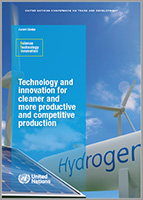
We live in a time of rapid technological change, at the height of the push for digital transformation and the early stages of the Industry 4.0 revolution. These technological waves have great potential to help the global community to bring about the transformations needed to achieve the SDGs, reduce poverty, tackle climate change, and put the world on a sustainable path. They also offer a window of opportunity for developing countries to catch up technologically and narrow global divides.
Critical areas for innovation in this new technological revolution are renewable energy technologies and frontier technologies for sustainable production and consumption. Innovation in these areas could help diversify economies and create higher- wage jobs while protecting the planet.
This study focuses on national strategies and policies related to green technology and green innovation for cleaner, more productive, and competitive production, and the role of international cooperation, including triangular and South-South cooperation, in supporting developing countries to benefit from windows of opportunity for developing, using, adopting and adapting these frontier technologies in production processes for catching up economically and technologically.
There are sound environmental, social, and economic reasons to support green technologies' development, diffusion, and implementation. Not only can they help to address current environmental problems, but there are valuable economic benefits in the form of job creation and alleviation of poverty and socio-economic inequality associated with their implementation.
It is mainly in response to global ecological and socio-economic pressures that countries worldwide have begun to focus on sustainable development agendas and green economic growth, in which green technologies play a central role.
Questions addressed in this paper include:
- What should countries do to take advantage of this window of opportunity?
- How could the international community support developing countries in this regard?
The paper is structured as follows.
The next three sections set the stage by discussing greener growth paths and innovation's role (Section II), examining the concept and main characteristics of green technology and innovation (Section III) and trends affecting green innovation (Section IV).
Section V looks at green windows of opportunities for countries to catch up, focusing on three areas: the production of renewable energy technologies, the greening of global value chains through the adoption of Industry 4.0 technologies, and the diversification of economies towards greener sectors.
Section VI discusses the facilitation of technology transfer of green technologies through ODA, trade and FDI, while Section VII presents the initiatives of the United Nations System in this regard.
Section VIII examines ways for harnessing green technology and innovation for inclusive and sustainable development. And Section IX presents a brief conclusion and recommendations for the consideration of Governments and the international community.
The study also includes two Annexes: Annex A highlights relevant technical cooperation programmes of the United Nations System, and Annex B lists suggested questions for discussion to facilitate the dialogue on green technology at the Intersessional Panel of the Commission in October 2022.





